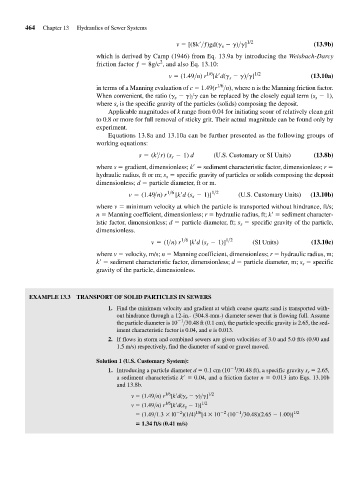Page 506 - Fair, Geyer, and Okun's Water and wastewater engineering : water supply and wastewater removal
P. 506
JWCL344_ch13_457-499.qxd 8/7/10 8:49 PM Page 464
464 Chapter 13 Hydraulics of Sewer Systems
v [(8k >ƒ)gd(g s g)>g] 1/2 (13.9b)
which is derived by Camp (1946) from Eq. 13.9a by introducing the Weisbach-Darcy
2
friction factor ƒ 8g/c , and also Eq. 13.10:
1/6
v (1.49>n) r [k d(g s g)>g] 1/2 (13.10a)
1/6
in terms of a Manning evaluation of c 1.49(r >n), where n is the Manning friction factor.
When convenient, the ratio (g s g)>g can be replaced by the closely equal term (s s 1),
where s s is the specific gravity of the particles (solids) composing the deposit.
Applicable magnitudes of k range from 0.04 for initiating scour of relatively clean grit
to 0.8 or more for full removal of sticky grit. Their actual magnitude can be found only by
experiment.
Equations 13.8a and 13.10a can be further presented as the following groups of
working equations:
s = (k¿>r) (s - 1) d (U.S. Customary or SI Units) (13.8b)
s
where s gradient, dimensionless; k sediment characteristic factor, dimensionless; r
hydraulic radius, ft or m; s s specific gravity of particles or solids composing the deposit
dimensionless; d particle diameter, ft or m.
v = (1.49>n) r 1>6 [k¿d (s - 1)] 1>2 (U.S. Customary Units) (13.10b)
s
where v minimum velocity at which the particle is transported without hindrance, ft/s;
n Manning coefficient, dimensionless; r hydraulic radius, ft; k sediment character-
istic factor, dimensionless; d particle diameter, ft; s s specific gravity of the particle,
dimensionless.
v = (1>n) r 1>6 [k¿d (s - 1)] 1>2 (SI Units) (13.10c)
s
where v velocity, m/s; n Manning coefficient, dimensionless; r hydraulic radius, m;
k sediment characteristic factor, dimensionless; d particle diameter, m; s s specific
gravity of the particle, dimensionless.
EXAMPLE 13.3 TRANSPORT OF SOLID PARTICLES IN SEWERS
1. Find the minimum velocity and gradient at which coarse quartz sand is transported with-
out hindrance through a 12-in.- (304.8-mm-) diameter sewer that is flowing full. Assume
1
the particle diameter is 10 >30.48 ft (0.1 cm), the particle specific gravity is 2.65, the sed-
iment characteristic factor is 0.04, and n is 0.013.
2. If flows in storm and combined sewers are given velocities of 3.0 and 5.0 ft/s (0.90 and
1.5 m/s) respectively, find the diameter of sand or gravel moved.
Solution 1 (U.S. Customary System):
1. Introducing a particle diameter d 0.1 cm (10 1 /30.48 ft), a specific gravity s s 2.65,
a sediment characteristic k 0.04, and a friction factor n 0.013 into Eqs. 13.10b
and 13.8b.
1/6
v (1.49>n) r [k d(g s g)>g] 1/2
1/6
v (1.49>n) r [k d(s 1)] 1/2
s
1
2
1/6
(1.49>1.3 l0 )(1/4) [4 10 2 (10 >30.48)(2.65 1.00)] 1/2
1.34 ft/s (0.41 m/s)

